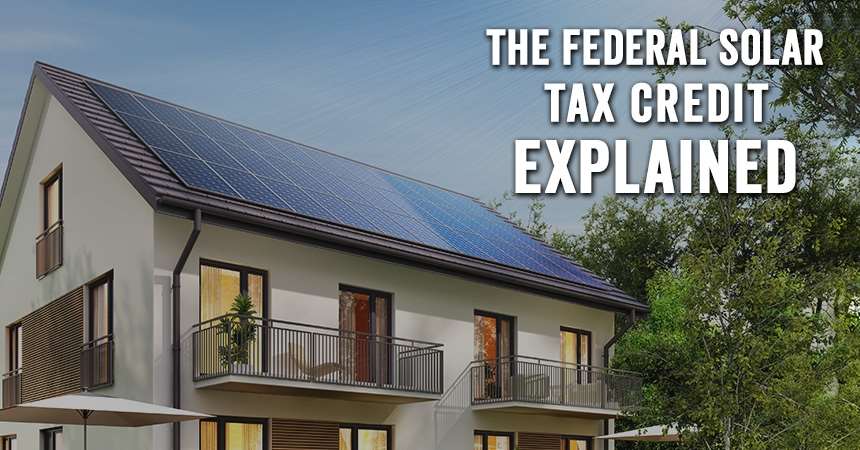A Deep Dive on The Solar Investment Tax Credit (ITC) and How it Works

A Deep Dive on The Solar Investment Tax Credit (ITC) and How it Works
A Deep Dive on The Solar Investment Tax Credit (ITC) and How it Works
A tax credit is a dollar-for-dollar reduction in the amount of income tax you would otherwise owe. For example, claiming a $1,000 federal tax credit reduces your federal income taxes due by $1,000. The federal tax credit is sometimes referred to as an Investment Tax Credit, or ITC, though is different from the ITC offered to businesses that own solar systems.
What is the Federal Solar Investment Tax Credit (ITC)?
The federal residential solar energy credit is a tax credit that can be claimed on federal income taxes for a percentage of the cost of a solar PV system paid for by the taxpayer.
The solar tax credit is a non-refundable credit worth 30% of the gross system cost of your solar project. That means that if the gross system cost is $20,000, your tax credit would be $6,000 ($20,000 x 30% = $6,000).
The installation of the system must be complete during the tax year that you plan to claim it on.
It’s important to note that the solar tax credit is not a check the automatically comes in the mail when you install a solar system. It is a credit that can lower your federal income tax liability to increase your refund or decrease how much you owe.
So, if you installed a $20,000 solar system and it’s deemed operational by a city inspector in 2023, then you can claim a $6,000 tax credit on your 2023 federal income tax return that you file in 2024. If your tax liability is greater than $6,000, you’ll be able to claim the entire credit in one year. If your tax liability is lower than $6,000, you can roll the remaining credit into future tax years.
There is no maximum amount that can be claimed.
Am I eligible to claim the federal solar tax credit?
You might be eligible for this tax credit if you meet the following criteria:
- Your solar PV system was installed between January 1, 2017, and December 31, 2034.
- The solar PV system is located at a residence of yours in the United States.
- You own the solar PV system (i.e., you purchased it with cash or through financing but you are neither leasing the system nor nor paying a solar company to purchase the electricity generated by the system).
- The solar PV system is new or being used for the first time. The credit can only be claimed on the “original installation” of the solar equipment.
What does the solar tax credit cover?
The gross system cost includes:
- Solar panels, inverters, and balance-of-system equipment (racks and conduit)
- Installation labor
- Permitting fees, inspection costs & other soft costs
- Sales tax
- Energy storage (battery backup)
Can the solar tax credit be combined with other solar incentives?
Yes, the solar tax credit can be combined with solar incentives from your state, local government, or utility provider.
Typically, local incentives should be claimed first to reduce the overall cost of the system, and the federal tax credit is claimed later on the lesser amount.
REBATE FROM MY ELECTRIC UTILITY TO INSTALL SOLAR
Under most circumstances, subsidies provided by your utility to you to install a solar PV system are excluded from income taxes through an exemption in federal law. When this is the case, the utility rebate for installing solar is subtracted from your system costs before you calculate your tax credit. For example, if your solar PV system installed in 2023 cost $20,000, and your utility gave you a one-time rebate of $1,000 for installing the system, your tax credit would be calculated as follows:
($20,000 - $1,000) * 0.30 = $5,700
However, payments from a public utility to compensate for excess generated electricity not consumed by the taxpayer but delivered to the utility’s electrical grid (for example, net metering credits) are not subsidies for installing qualifying property and do not affect the taxpayer’s credit qualification or amounts.
PAYMENT FOR RENEWABLE ENERGY CERTIFICATES
When your utility, or other buyer, gives you cash or an incentive in exchange for renewable energy certificates or other environmental attributes of the electricity generated (either upfront or over time), the payment likely will be considered taxable income. If that is the case, the payment will increase your gross income, but it will not reduce the federal solar tax credit. Note: A private letter ruling may not be relied on as precedent by other taxpayers.
REBATE FROM MY STATE GOVERNMENT
Unlike utility rebates, rebates from state governments generally do not reduce your federal tax credit. For example, if your solar PV system was installed in 2023, installation costs totaled $20,000, and your state government gave you a one-time rebate of $1,000 for installing the system, your federal tax credit would be calculated as follows:
$20,000 * 0.30 = $6,000
STATE TAX CREDIT
State tax credits for installing solar PV generally do not reduce federal tax credits—and vice versa. However, when you receive a state tax credit, the taxable income you report on your federal taxes may be higher than it otherwise would have been because you now have less state income tax to deduct. (The Tax Cuts and Jobs Act of 2017 placed a $10,000 limit on state and local tax (SALT) deduction through 2025. Therefore, if a homeowner is still paying more than $10,000 in SALT after claiming a state tax credit, the state tax credit benefit would not effectively be reduced by the federal tax rate, as it would not impact federal taxes (due to the SALT limit).) The end result of claiming a state tax credit is that the amount of the state tax credit is effectively taxed at the federal tax level.
How To Claim Your Tax Credit?
To claim the ITC you will need to file under IRS From 5695 for that tax year that your system was deemed operational (approved by a city inspector). If you can’t claim the entire credit in one year, it can be rolled over into future tax years.
After seeking professional tax advice and ensuring you are eligible for the credit, you can complete and attach IRS Form 5695 to your federal tax return (Form 1040 or Form 1040NR). Instructions on filling out the form are available here.
The Federal Solar Investment Tax Credit Makes Going Solar a No-Brainer!
As the greatest and most widely-available solar incentive, it’s important to know how the federal solar tax credit works.With a little extra paperwork during tax season, claiming the solar tax credit can reduce the overall cost of your solar and/or battery storage system by 30%. This increases your overall energy cost savings and reduces the payback period of going solar.
Always consult a licensed tax professional with questions about your tax liability and claiming tax credits.
Viridis Energy - The Solar Experts
Viridis Energy is an award winning residential and commercial solar provider based out of Boston, MA. We are the leading SunPower dealer and installer in Massachusetts.
To schedule a virtual or in-home appointment, you can fill out the form below. We have a friendly team ready to help homeowners looking to make a difference for both their utility bill and the environment, Viridis Energy offers quality, experience, and efficiency built into every home solar system!
SEE HOW MUCH YOU CAN SAVE BY GOING SOLAR
CALCULATE YOUR SAVINGS
